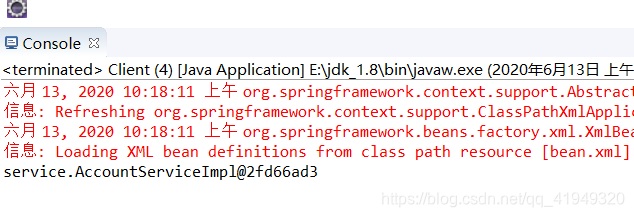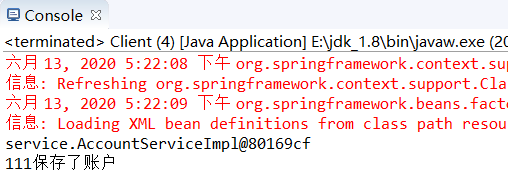之前我们基于XML文件的配置是这样写的:
<bean id="accountService" class="service.AccountServiceImpl"
scope="" init-method="" destroy-method="">
<property name="" value="" | ref=""></property>
</bean>
这次我们来看看用注解的方式,如何写?
一、@Component
作用:用于把当前类对象存入spring容器中

属性:
value:用于指定bean的id。当我们不写时,它的默认值是当前类名,且首字母改小写。
(当只有一个属性且这个属性是Value时,可以@Component("accountService"))
栗子:
1)保存账户的接口
public interface IAccountService {
/**
* 保存账户
*/
void saveAccount();
}
2)使用注解的类 AccountServiceImpl
@Component("accountService")
public class AccountServiceImpl implements IAccountService {
private IAccountDao accountDao = null;
public void init(){
System.out.println("初始化方法执行了");
}
public void destroy(){
System.out.println("销毁方法执行了");
}
public void saveAccount(){
accountDao.saveAccount();
}
}
- bean.xml 用来指定注解配置信息在哪个包下
<?xml version="1.0" encoding="UTF-8"?>
<beans xmlns="http://www.springframework.org/schema/beans"
xmlns:xsi="http://www.w3.org/2001/XMLSchema-instance"
xmlns:context="http://www.springframework.org/schema/context"
xsi:schemaLocation="http://www.springframework.org/schema/beans
http://www.springframework.org/schema/beans/spring-beans.xsd
http://www.springframework.org/schema/context
http://www.springframework.org/schema/context/spring-context.xsd">
<context:component-scan base-package="service"></context:component-scan>
</beans>
4)表现层
public class Client {
public static void main(String[] args) {
//1.获取核心容器对象
ApplicationContext ac = new ClassPathXmlApplicationContext("bean.xml");
//2.根据id获取Bean对象
IAccountService as = (IAccountService)ac.getBean("accountService");
System.out.println(as);
//as.saveAccount();
}
}
运行截图:如图我们使用注解的方式,成功创建对象了!

由 @Component 衍生的注解:
@Controller:一般用在表现层
@Service:一般用在业务层
@Repository:一般用在持久层
以上三个注解他们的作用和属性与Component是一模一样。
他们三个是spring框架为我们提供明确的三层使用的注解,使我们的三层对象更加清晰
存在的问题:
当我们放开 as.saveAccount(); 会报空指针异常java.lang.NullPointerException!!!
由于AccountServiceImpl中的accountDao这个变量为null,所以出现了空指针异常!
二、用于注入数据的注解 —— @Autowired
注入数据的注解 的作用就和在xml配置文件中的bean标签中写一个标签的作用是一样的
Autowired:
作用:自动按照类型注入。只要容器中有唯一的一个bean对象类型和要注入的变量类型匹配,就可以注入成功
出现位置:可以是变量上,也可以是方法上
细节:在使用注解注入时,set方法就不是必须的了。
如何改写上面的栗子,使其不报空指针异常呢???
1)保存账户的接口:
public interface IAccountDao {
void saveAccount();
}
2)接口的实现类,注意在实现类上写注释
@Component("accountDao")
public class AccountDaoImpl implements IAccountDao{
public void saveAccount(){
System.out.println("保存了账户");
}
}
3)给要注入的对象上,加上注释 @Autowired 按照类型自动注入

4)bean.xml中加上一句:
<context:component-scan base-package="dao"></context:component-scan>

分析:
以上这个情况是,容器中有唯一的一个bean对象类型和要注入的变量类型匹配,此时注入成功!
- 如果ioc容器中没有任何bean的类型和要注入的变量类型匹配,则报错。
- 如果Ioc容器中有多个类型匹配时:那该如何呢???
假设出现两个AccountDao的实现类:
@Component("accountDao1")
public class AccountDaoImpl implements IAccountDao{
public void saveAccount(){
System.out.println("111保存了账户");
}
}
@Repository("accountDao2")
public class AccountDaoImpl2 implements IAccountDao {
public void saveAccount(){
System.out.println("222保存了账户");
}
}
此时又该怎么办呢???
@Qualifier就是为了解决这个问题而出现的
二、用于注入数据的注解 —— @Qualifier:
作用:在按照类中注入的基础之上再按照名称注入。它在给类成员注入时不能单独使用。但是在给方法参数注入时可以
属性:value:用于指定注入bean的id。
注意:不能独立使用,得和@Autowired结合使用

@Qualifier指定的bean的id是acountDao1,所以此时给accountDao1注入:

但是每次都得结合@Autowired使用,太麻烦辣!!!
@Resource 就是为解决这个问题而出现的
三、用于注入数据的注解 —— @Resource:
作用:直接按照bean的id注入。它可以独立使用
属性:name:用于指定bean的id。


以上三个注入都只能注入其他bean类型的数据,而基本类型和String类型无法使用上述注解实现。另外,集合类型的注入只能通过XML来实现。
那基本类型和String类型 怎样注入呢???
@Value 就是为解决这个问题而出现的
四、用于注入数据的注解 —— @Value:
作用:用于注入基本类型和String类型的数据
属性:
value:用于指定数据的值。它可以使用spring中SpEL(也就是spring的el表达式)
SpEL的写法:${表达式}
Q:咱们之前学习JSP的时候,也用到了el表达式,JSP的el是从四大域中取值的。那这里的el表达式是从哪儿取值的呢???
A:就看 ${表达式} 写到哪儿了。如果写到jsp文件中,那就是从四大域中取值的;如果写在Spring的配置文件或者注解中了,就会从Spring指定的位置取数据;如果写在Mybatis的配置文件或者注解中了,就会从Mybatis指定的位置取数据。
五、用于改变作用范围的注解 —— @Scope
他们的作用就和在bean标签中使用scope属性实现的功能是一样的
作用:用于指定bean的作用范围
属性: value:指定范围的取值。常用取值:singleton(默认的) prototype


六、和生命周期相关的注解 —— @PreDestroy
他们的作用就和在bean标签中使用init-method和destroy-methode的作用是一样的
@PreDestroy
作用:用于指定销毁方法
@PostConstruct
作用:用于指定初始化方法
AccountServiceImpl,注意多态对象是不能虽然容器的关闭而销毁的

Client
public class Client {
public static void main(String[] args) {
//1.获取核心容器对象
ClassPathXmlApplicationContext ac = new ClassPathXmlApplicationContext("bean.xml");
//2.根据id获取Bean对象
IAccountService as = (IAccountService)ac.getBean("accountService");
as.saveAccount();
ac.close();
}
}
运行结果:






















 1万+
1万+











 被折叠的 条评论
为什么被折叠?
被折叠的 条评论
为什么被折叠?








